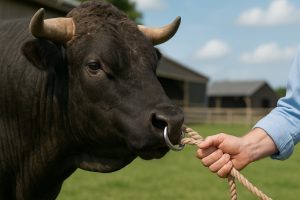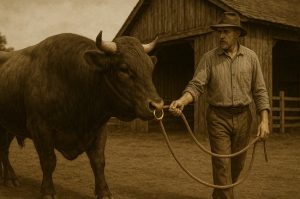Why do bulls have nose rings, and why has this practice continued for centuries? Bulls are large, powerful animals that can be unpredictable and sometimes aggressive. Farmers and handlers must work closely with them for breeding, transport, and health checks, which creates risks.
A nose ring provides a safe and practical way to manage these animals. By attaching a rope, chain, or bull staff to the ring, the handler gains greater control without the need for excessive force. Because the septum of the nose is extremely sensitive, even a slight pull on the ring causes the bull to respond.
In short, nose rings serve as a control tool, a safety measure, and in some cases, a management aid in farming tasks.
How Do Bull Nose Rings Actually Work?

The nose ring functions through the sensitivity of the nasal septum. When a rope, chain, or staff is attached, the handler gains leverage. A gentle pull is usually enough to guide the bull in the desired direction, reducing the risk of injury to both the handler and the animal.
The ring can also serve as a deterrent. Some farmers leave a short chain or rope hanging from the ring. If the bull attempts to charge, it may step on the chain, which causes sudden discomfort and interrupts the behaviour. In organised environments such as cattle shows, the ring is often connected to a bull staff, a pole with a hook that provides additional distance and control.
This combination of leverage, deterrence, and controlled discomfort explains why the ring is such an effective tool in farming.
Why Do Bulls Require Such Strong Control Methods?
Bulls are not like cows. While cows are generally manageable with halters, bulls are heavier, stronger, and more territorial. A mature bull may weigh well over a tonne, and a sudden movement or display of aggression can easily overpower a human. Even bulls that are not intentionally aggressive can cause harm by pushing through barriers or dragging handlers.
During the breeding season, bulls are particularly prone to aggressive displays. A nose ring provides a way to guide and restrain them safely, especially when moving them from one area to another, conducting veterinary examinations, or transporting them to markets and shows.
Without such tools, accidents on farms would be far more common, as bulls are consistently listed among the most dangerous livestock animals in the UK.
Are Nose Rings Used for Purposes Other Than Control?
Yes, the role of the nose ring extends beyond simple restraint. They are required at many cattle shows, where bulls must be handled in close proximity to other animals and people. In these settings, the nose ring is a safety requirement that helps maintain order.
Nose rings are also used during routine handling on farms. Moving bulls between fields, loading them into trailers, or securing them for veterinary checks are all situations where the nose ring makes the process safer and more efficient.
Beyond bulls, nose rings are used in a different way for calves. Calves are sometimes fitted with temporary plastic nose rings that include small spikes.
These spikes press against the mother’s udder when the calf attempts to suckle, discouraging feeding and allowing farmers to wean the calf more easily without separating it from the herd immediately. This demonstrates that nose rings can have roles in farming beyond controlling aggression.
What Is the History of Using Nose Rings in Bulls?

The practice of fitting bulls with nose rings is not new. Historical evidence suggests that nose rings were used in Europe and Asia as early as the Middle Ages. Initially, they may have held cultural or symbolic value, but they quickly became recognised as a practical farming tool.
Over centuries, the design of the rings improved, moving from rudimentary materials to durable metal rings with secure locks. Today, their use continues not out of tradition alone but because they remain one of the most effective tools for managing bulls safely in farming systems across the UK.
Do Nose Rings Cause Pain to Bulls?
The insertion of a nose ring is a procedure that causes temporary discomfort, similar to ear tagging or dehorning. However, once the wound heals, the ring itself does not usually cause ongoing pain. The discomfort only occurs when pressure is applied to guide or restrain the bull.
UK animal welfare standards stipulate that nose rings must be fitted by competent individuals, often a veterinarian or experienced farmer, to minimise the risk of infection or complications. When fitted correctly and cared for properly, the nose ring provides control without long-term harm.
Temporary plastic nose rings used for calves are even less invasive, as they are clipped on and removed once weaning is complete.
What Alternatives Exist to Nose Rings?
Some farms adopt alternatives to nose rings, particularly where animal welfare is prioritised. Cattle crush systems, for example, restrain bulls securely during veterinary procedures without the need for constant nose control. Training and calm handling techniques are also promoted, particularly when bulls are managed from a young age.
However, these methods have limitations. Behavioural training may reduce the need for nose rings but cannot eliminate the risk entirely, particularly with mature breeding bulls.
Tools such as electronic prods exist but are discouraged due to their negative impact on welfare. For many farmers, the nose ring remains the most balanced option between safety, practicality, and welfare.
How Do Farmers Use Nose Rings in Practice?

In everyday farming life, nose rings are used whenever bulls need to be handled directly. A farmer leading a bull into a trailer, moving it between fields, or presenting it at a show can guide the animal with minimal force. Veterinary inspections, blood tests, and treatments also become safer with the added control a nose ring provides.
A farmer in Devon, for example, described how his prize breeding bull could only be safely taken to agricultural competitions by using both a nose ring and bull staff. Without this, the risk of injury to himself, his staff, or other animals would have been too high.
This shows that nose rings are not just theoretical tools but are part of the everyday reality of safe livestock management.
Do Other Animals Have Nose Rings Too?
Nose rings are not exclusive to bulls. Pigs are often fitted with smaller rings to prevent rooting behaviour, which can damage fields and fencing. Calves, as mentioned earlier, may wear temporary spiked rings to aid weaning. Cows, however, rarely require them because they are less aggressive and more easily handled with halters.
The purpose differs between species, but the principle remains the same: the nose ring provides control or modifies behaviour through the sensitivity of the nose.
Why Do Bulls Still Have Nose Rings Today?
Despite modern alternatives, bulls continue to be fitted with nose rings for several clear reasons. They ensure handler safety, allow for effective control of powerful animals, and support everyday farming practices ranging from transport to veterinary care. They are also required in many competitive and exhibition settings.
While animal welfare remains an important consideration, when used correctly, nose rings are widely regarded as a practical, humane solution that balances control with safety.
Comparing Bull Control Methods
| Method | Effectiveness | Animal Welfare Impact | Common Usage |
| Nose Ring | High | Moderate (short-term discomfort) | Standard in bulls, required at shows |
| Halter | Medium | Low | Common for cows, limited use in bulls |
| Bull Staff | High | Moderate | Used with rings for extra control |
| Cattle Crush | High | Low | Veterinary and health procedures |
| Behavioural Training | Medium | Low | Growing use in welfare-focused farms |
FAQs
Do all bulls have nose rings?
Not all bulls are fitted with nose rings, but many farms continue to use them for safety and handling.
At what age are bulls fitted with nose rings?
Bulls are typically fitted between 9 and 12 months of age, when the tissue is developed enough to hold the ring securely.
Are nose rings permanent?
Most bull nose rings are permanent, although some temporary versions are used for training or specific management purposes.
Do nose rings cause lasting harm?
Once healed, the ring does not usually cause pain unless pressure is applied. Proper fitting and care ensure the animal’s welfare.
Why don’t cows wear nose rings?
Cows are generally docile and manageable with halters, so they do not usually require nose rings.
Can nose rings prevent bull attacks?
They cannot guarantee prevention, but they act as a strong deterrent. A dangling chain, for example, can stop a bull mid-charge if stepped on.
What is the difference between bull nose rings and calf weaning rings?
Bull nose rings are permanent metal fittings for control. Calf weaning rings are plastic, temporary, and designed to discourage nursing.






